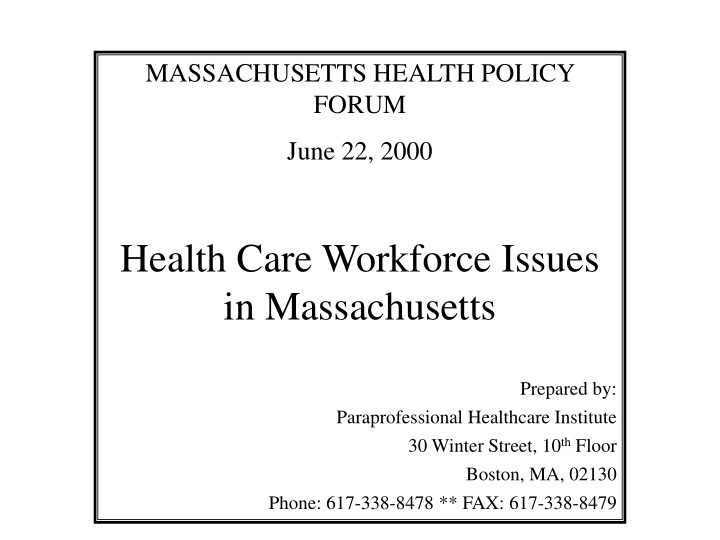



MASSACHUSETTS HEALTH POLICY FORUM June 22, 2000 Health Care Workforce Issues in Massachusetts Prepared by: Paraprofessional Healthcare Institute 30 Winter Street, 10 th Floor Boston, MA, 02130 Phone: 617-338-8478 ** FAX: 617-338-8479
Workforce and Welfare Systems Health Care System Provider Practice The Care-giving Connection – Health Care Consumers and Direct Care Workers Quality Management Third-party Investment in Workforce Support for Employment - and Opportunities for Advancement
Unemployment rate < 3% People are working… They’re just not working in health care… Vacancy Rates > 12%
Downward Spiral Poor Quality Jobs Staff go elsewhere Understaffing for work gets worse; jobs get More worse staff leave
Elderly and Women of Care-Giving Age 1,600,000 1,400,000 1,200,000 1,000,000 800,000 Females 25 - 54 Elderly 65+ 600,000 400,000 200,000 0 2000 2005 2010 2015 2020 2025 Source: U.S. Census Bureau, Population Estimates Program at www.census.gov/population/estimates/state
Staffing Crisis: Demand - Supply - Price Supply: Demand: • Decreasing workforce • Growing aging population • Decreasing 25-54 year old population • Higher acuity • Lots of better options • Labor intensive Price: Wages, Benefits, Workloads, Training, Opportunities for Advancement, Respect, Overall Working Conditions
What Health Care Pays for Labor – Poor Quality Jobs: • Wages – half what’s needed for family self -sufficiency • Benefits – many lack health insurance • Workloads – rushed care; over-time; injuries; • Training – inadequate preparation and few opportunities for advancement • Overall Working Conditions – negative work culture
Poor Quality JobsAffect Quality Care High turnover and high vacancy rates: • Disrupt continuity and individualized care • Cause physical and psycho-social deterioration Malnutrition, dehydration, incontinence, skin breakdown Isolation, loneliness, depression • Divert resources from care to turnover • Lose experienced mentors on staff
Framework for Action • Sectoral – In long term care – home and facility-based • Intersect health care / workforce systems – In policy, program, data collection and planning • Staged – Immediate action to stem the downward spiral – Longer term planning, oversight and implementation
Immediate and Longer Term Action • Immediate – stem the downward spiral – – Action now to retain and attract direct care workers – Long-term care as a Gateway to Employment – support new entrants to the workforce • Long-term – workforce strategy thru 2030 – – Workforce Commission – Coordinated data analysis and dissemination
Workforce Development Health Care System Higher wages and benefits Pathways to Advancement Upgrade training Incumbent Worker Training Employer Higher staffing standards Counseling and Assistance Culture change DIRECT CARE WORKERS Pre-and post-employment education and services: Medicaid Expansion: Expand health - Child-care and transportation assistance care coverage to health care workers - Adult Basic Education Access to Quality Jobs Access to Health Care
Immediate Action to Stabilize Workforce: Make Direct Care Jobs Competitive in the Labor Market Wages Raise wage levels Benefits Provide health insurance Training Improve entry-level training Create pathways to advancement Workload Establish safe staffing levels Treatment Quality management and supervision Support Assist workers entering the workforce
Improving Wages and Benefits • Wages – – Wage pass-through – Recalibrate wages through step increases – Evaluate wages within labor market • Health Insurance – – Expand coverage under public programs – Subsidize employer-based insurance – Maximize CHIP
Training • Improve curriculum and teaching methods for pre-service and in-service training • Increase length of preparatory period, add orientation period • Provide training specific to care needs • Develop opportunities for advancement • Provide Adult Basic Ed
Career Pathways in Long Term Care Opportunities for Advancement LPN – RN Scheduler, Therapy Assistant, Therapies Phlebotomist, Certified Aide Plus: Technician, Medical Records Senior Aide, Mentor, Need community college, tuition Specialty Skills assistance and stipends to manage work and study Certified Home-maker, Need training programs, Home Health Aide, community college, help Nursing Assistant to work and study Certified-plus positions: Non-certified LTC staff: Need work-based skills development training and Kitchen, housekeeping post-employment retention services Certified positions: Provide work-based training in Adult Basic Ed, care- Pre-certified positions: giving and life-skills. Provide ESoL, GED, literacy Post-employment retention services Post-employment retention services
Workloads and Working Conditions • Workloads – Safe staffing levels – Sufficient hours for full-time work • Working Conditions – Culture Change – Inclusive Management – Quality Supervision – Team approaches – Peer support
Gateway to Employment – Supports for New Workers • Adequate preparation for successful employment • Support to overcome barriers to work • Post-employment counseling and job retention assistance • Incumbent worker training in Adult Basic Ed and skills upgrades
Efforts Already Underway • Legislative – Joint hearings; proposed budget provides comprehensive approach • Stakeholders – Consumers, labor, and providers are working together within long-term care • Provider Practice – LTC associations are collaborating to develop better management and supervision practices • Workforce Development – Committed to long- term care as priority area
Longer Term Action: Provide a Workforce as Demand for Health Care Increases Coordination and Create a Health Care Workforce Oversight Commission through 2025 Restructure Make health care jobs more Workforce Policy competitive in labor market Data Collection; Report on labor market and Public Disclosure health care utilization data Education Fund nursing education and on- the-job skills development Culture Change Improve the quality of the health care work environment
Recommend
More recommend